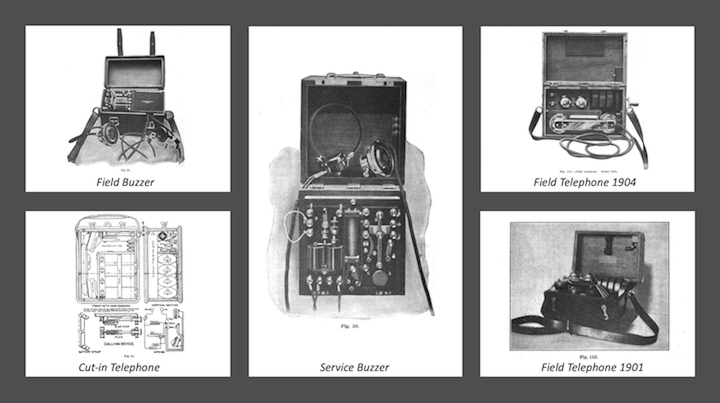
The origins of the U.S. Army Signal Corps go back to the 1860ies. Initially visual signalling (Flags, Torches) was used, soon to be extended by wireline telegraphy and soon after it's invention in 1876 stationary telephony. The first portable field telephones were introduced by the turn of the century [23] [51].
This essay presents the timeline from the first to the last analog wireline local battery field telephones based on U.S. signal corps publications referenced in the text.
Black and white pictures are taken from the referenced publications (all in the public domain), color pictures are from instruments in my collection.
For the pre WWI devices the signal corps differentiates between "buzzers" which are instruments with a "make and break vibrator" setup to generate buzz tones for morse tone transmission and "telephones" which were portable versions of LB telephones with magneto, AC ringer and handset. The buzzers were also equipped with a microphone for speech transmission and also described to be mainly used as telephones (without magneto/ringer signalling) [6].
Manual No. 1. Handbook of Telephones of the Signal Corps. from 1904 [1a] does describe two field telephones (Field Telephone and Cut-in Telephone) and two "Service Telephones"; Manual No. 3. Electrical Instruments and Telephones of the U.S. Signal Corps from 1905 [2] does describe seven portable field telephony instruments, two buzzers and five telephones:

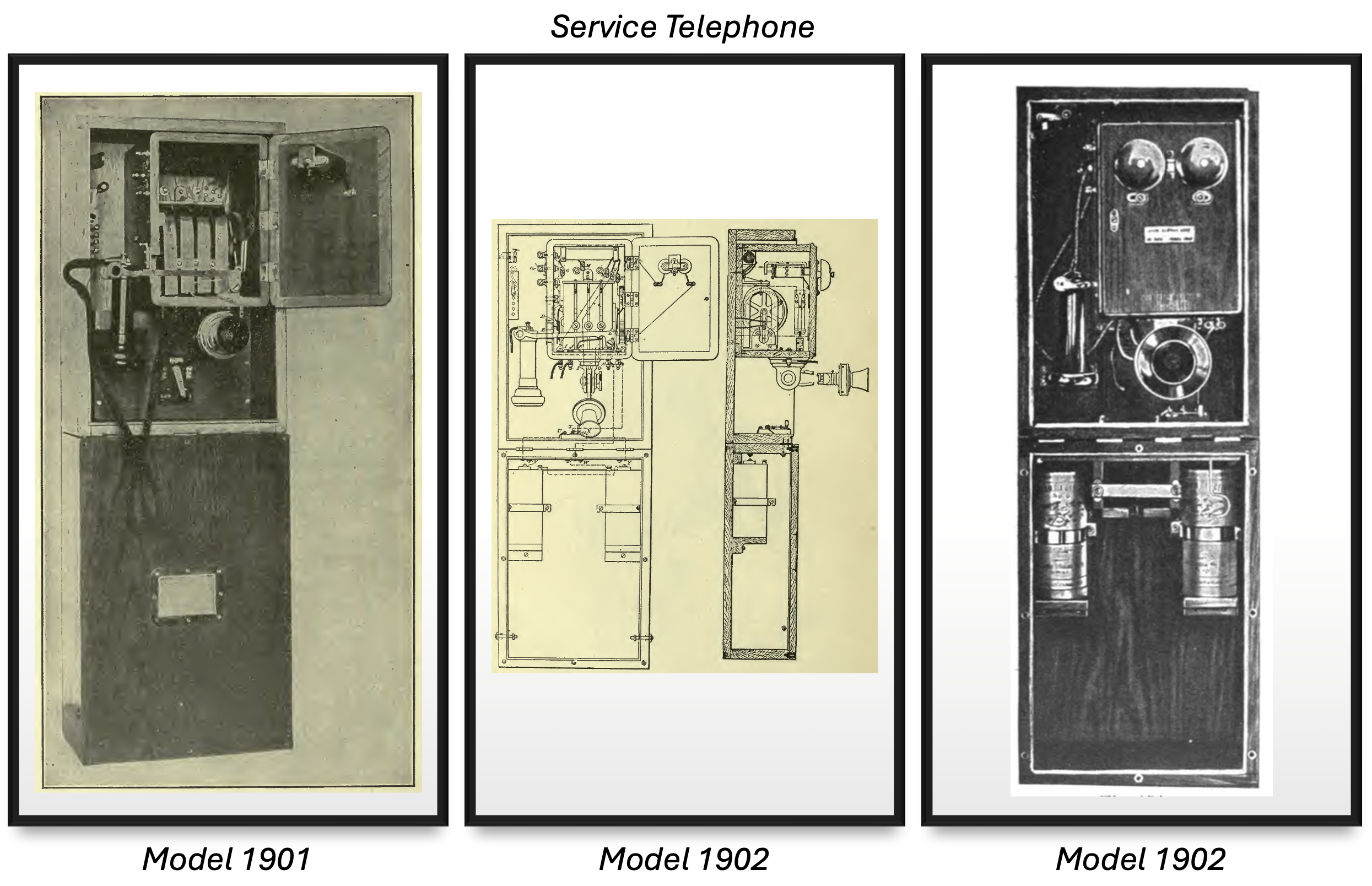
Manual No. 3. Electrical Instruments and Telephones of the U.S. Signal Corps from 1910 [5] does also describe 5 portable field telephony instruments, again two buzzers and three telephones (The Cut-in Telephone is still Model 1905):

Manual No. 3. Technical Equipment of the Signal Corps from 1916 [7] does mention a buzzer and a telephone which replace the above described "1910" equipment:
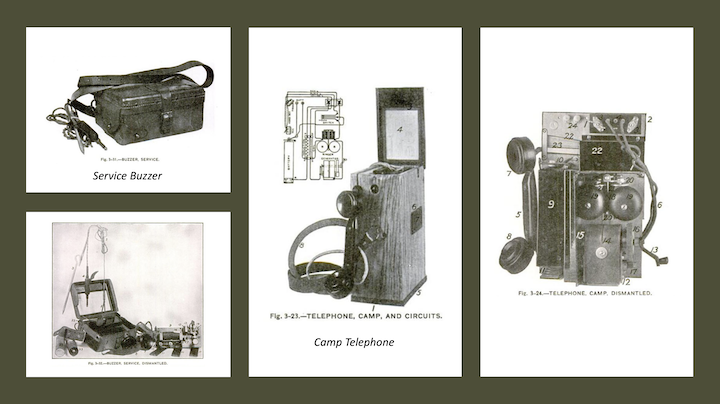
Shortly before or in parallel to the U.S. entering WWI (by war declaration to Germany in April 1917) the Signal Corps took a couple of new field telephony devices into service, the Field Telephone Model 1917, the Camp Telephone Model 1917 and Camp Telephone Model A and a standard Western Electric railroad portable Telephone (1375B), all of which replaced the Camp Telephone from 1913. Camp Telephone Model 1917 is an improvement of the Model 1913 design using a bigger magneto (3-Bar instead of 2), Model A is a further improvement adding a capacitor to the ringer. Field Telephone Model 1917 combines the camp telephone components with a buzzer, after realising in the field that buzzer communication is intercepted very easy in trench warfare, it was soon discontinued. The lightweight Western Electric standard device 1375B was introduced for the field artillery. [11] [23]
Electrical Engineering Pamphlet No. 3. from 1918 [11] does mention these three field telephone types already using electrical engineering numeration, EE-3, EE-4 and EE-5:
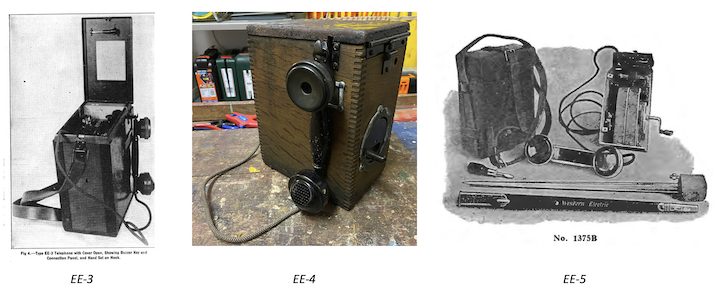
EE-4 and EE-4-A apparently were made only by Western Electric, EE-3 by Western Electric and Kellog. EE-3, EE-4 and EE-5 were used up and into WWII [22] [24] and with the Lend lease program ~1000 pcs. were still delivered to Mexico.
After the certain initial level of standardisation (at least compared to the "zoo" of predeceasing instruments) of the EE-3/4/5 models the introduction of the EE-8 brought the level of standardisation enabling the scale required by WWII just in time.
A field telephone called EE-8 is mentioned as early as 1922 in Primary Batteries. Training Pamphlet No. 7. [12]. It is mentioned to be under development and to be expected to replace the EE-3/4/5 "family", back then it was expected to still use a BA-1 type battery. Service test were procured from Automatic Electric in 1937 and after service testing it was standardised for production by 1938 [38]. When entering War in 1941 the Signal Corps had already ordered about 70k EE-8. U.S. production capacity for the EE-8 increased from 50 per day to a whopping 2000 per day [33] provided by eight manufacturers: Automatic Electric, Stromberg-Carlson, Kellogg, Leich, North Electric, Holtzer-Cabot, Connecticut Telephone and Electric and Western Electric [38]. Only with the Lend lease program nearly 500k were delivered (350k to the USSR alone). I assume the total WWII production was several times the number provided through the Lend lease program and that the total number of ever produced EE-8 may well be a good couple of millions. The instruments provided to the USSR had to be adapted to be able to use Russian batteries, there were also a specifically for Russia made instrument based on EE-8 components: IAA-44 and 2005-W.
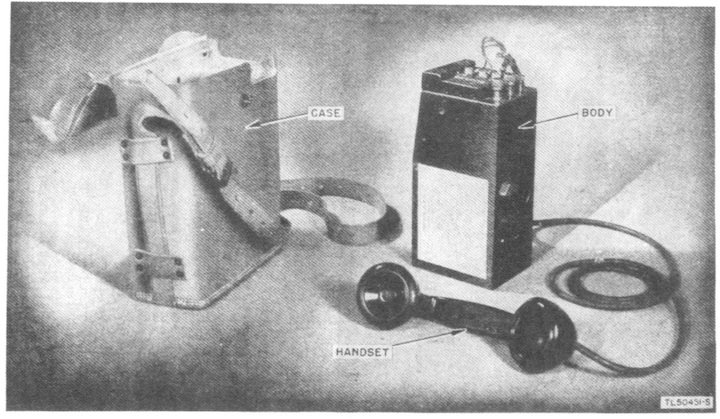
Design and feature-wise a clear successor of the EE-3/4/5 "family" but lighter, more robust and using a more practical battery type (2x 1,5V BA-30 instead of the 3V BA-1). The initial EE-8 was followed up by an EE-8-A (different capacitor and handset) and soon the EE-8-B (more efficient magneto and a steel sheet instead of aluminum sheet body). After WWII the EE-8 was refurbished to be used by several countries in Europe and worldwide. At least in Italy and Germany they were also licensed to manufacture locally. In the U.S. it is still mentioned in Field Wire Techniques, FM 24-20 from 1956 [32], but no longer in FM 24-20 from 1960 [36], by then it had been replaced by the next generation TA-43/PT. The EE-8 was also part of the EE-105 Lineman's telephone which added a filter unit to it to bridge into carrier lines, a 1000Hz whistle was included to signal to a carrier terminal [46].
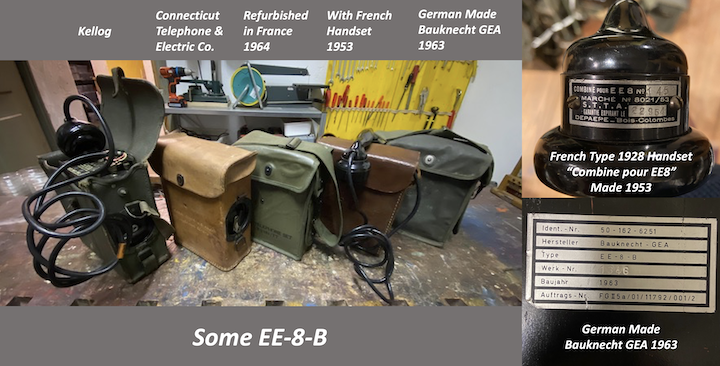
Click on picture for bigger version.
The EE-8 led to the development of Swiss Army FTf 50 [52] and maybe inspired partly the Norwegian TP-6N.
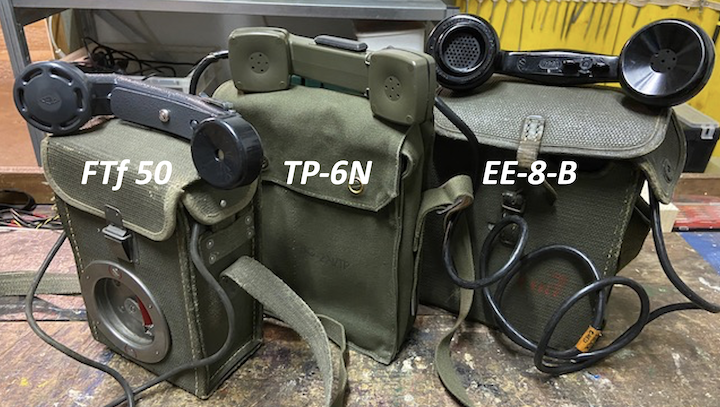
In the Korean War the U.S. Army continued to use the EE-8-(*). By 1952 the successor TA-43/PT [30] (developed by Bell Labs) was ready for procurement [30]. Compared to the EE-8 it had an increased talking range (22 Miles vs. 18 Miles [62]), was waterproof and a the handset was optimised to be used under a helmet, it still was powered by 2x BA-30. The TA-43/PT was replaced by the mostly identical TA-312/PT in 1956/57 [32]. The TA-312/PT uses the same case, handset and most of the same components but ads a connector which can be used to connect an external headset, later also a DTMF module which can be connected on the same connector has been developed. About 120k of TA-43/PT were produced and up to 1960 also already about the same amount of TA-312/PT [38]. The total production numbers are unknown (to mee), but assumed to be well into 7 figures worldwide. There was also a linemen's instrument called TA-263/PT (the successor of above mentioned EE-8 based EE-105), which was basically a standard TA-43/PT or TA-312/PT with an external filter set add-on to be able to bridge into carrier lines, a 1000Hz and a 1600Hz whistle was supplied for signalling on these lines [41].
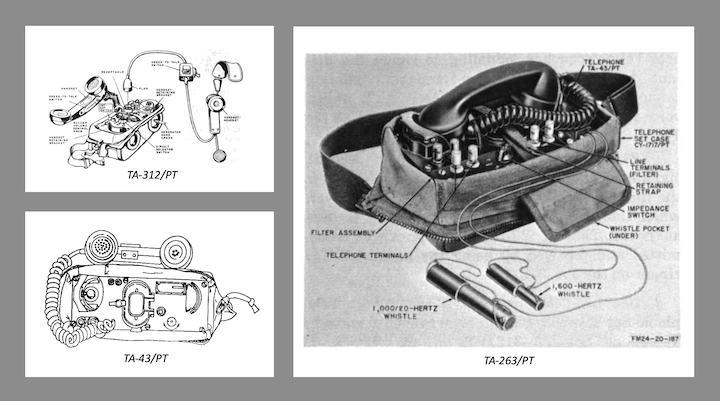
The TA-312/PT was and probably is still in use by several NATO armies worldwide and also influenced a couple of international field telephone designs like e.g. the Yugoslavian M-63 (1963), the Danish FT58 (1958), the Austrian F-27-0 (1980) and the French AT-75A (1989).
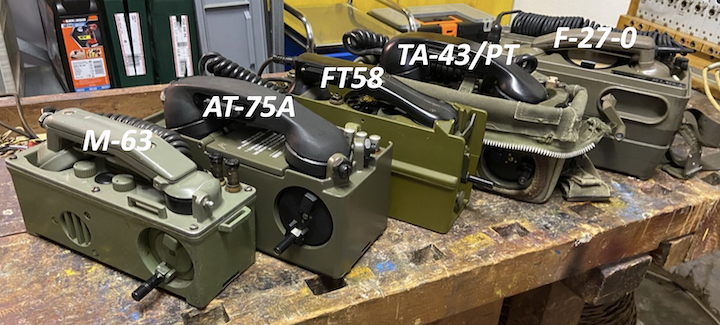
The TA-312/PT was the last field telephone using traditional 2-wire LB with magneto signalling. In the late 50ies the Signal Corps together with Stromberg-Carlson developed the transistorised TA-341()/PT for four wire operations with a 2-row DTMF number pad [38] [61]. The TA-341()/PT was field tested but apparently never introduced as standard into service. In the late 60ies or early seventies a four-wire desk set with DTMF dial pad was introduced as TA-341/TT [42]. The TA-838/TT developed in the 70ies [41] is the portable field version with DTFM dial pad with the AUTOVON precedence keys. It supports only shorter line lengths (2 miles) and is built to be combined with more modern manual switchboards or automatic switches. It supports a 4-wire point-to-point mode to interconnect just two TA-838/PT. These four-wire sets are not compatible with traditional field telephone systems.
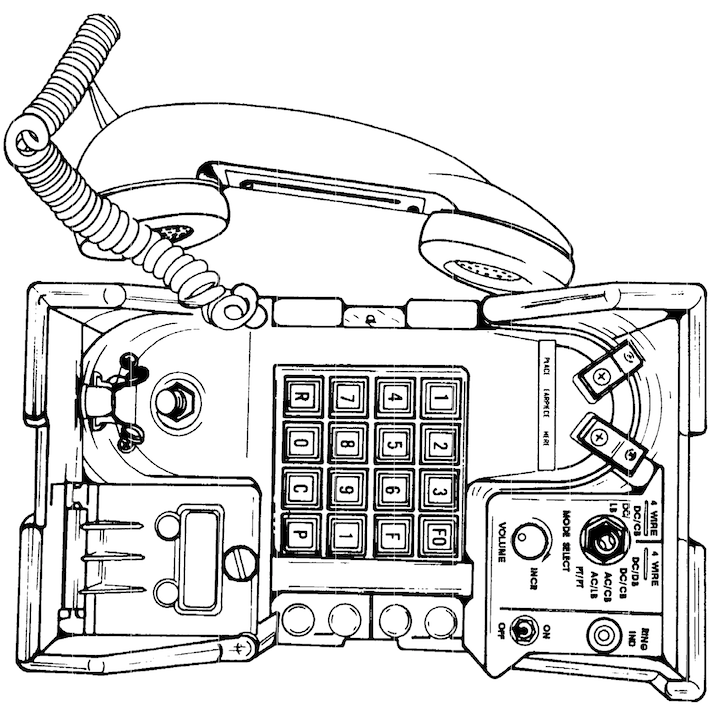
TA-838/TT is first mentioned in FM 24-25 1977 [42] with "Status: under development" and is still mentioned in FM 24-24 1994 [44].
The next field telephone sets introduced in the 80ies were then already using digital 12/32 kbps transmission like the TA-954/TT (non secure, also the similar TA-1035/U and TA-1042) and the TSEC-KY/68 (with encryption) [44].
The 2nd and 3rd generation devices (EE-3/4/5/8) were already sold surplus by the end of WWII (~$15 a piece - would be ~200$ in 2022) [71] [72] [73]. I'm still looking for sources for about when the 4th and 5th generation went into surplus. Today (2022) all types from EE-8 up to TA-954/TT are available from army surplus dealers. Earlier sets than EE-8 are more scarce and sold as collectors items.
Below table gives an overview of all above described instruments. The "generation" is my classification. The name and year of introduction are quite well established based on the listed sources, the year of retirement is only an educated guess from my side. Maybe TA-312/PT and TA-838/TT are still in use when simple fast to build point to point circuits are required somewhere, or as linemen's instruments. The instruments are also listed on the Global Field Telephones Comparison List with more feature information.
75% of all U.S. Signal Corps field telephones have been released before 1920, or if including the EE-8 then it is 80% before 1950. Then two instruments (TA-43/PT and TA-312/PT which in the end are basically only one as they are nearly identical) were added in the 50ies, and these sufficed until the end of the analog local battery field telephone era which I guess was around the end of the 20th century if not earlier.
Up to the EE-8 the field telephones had an "EE - Electrical engineering" equipment group designation, afterwards a "TA - Telephone Apparatus" designation. An exception was the TP-3 sound powered field telephone which used the "TP - Telephone" designation. My unsourced assumption is that /PT stands then for "portable telephone" and /TT maybe for "tactical telephone" (/TT is also used for e.g. the WD-1/TT wire and other wires and also some switchboards)? A good overview of the equipment groups and respective equipment assigned can be found on the very good radionerds webpage.
| Generation | Name | Year | Retired (assumption) | Weight [kg] | Battery |
|---|---|---|---|---|---|
| 1 | Field Telephone Model 1901 | 1901 | 1910 | ||
| Service Telephone Model 1901 | 1901 | 1910 | |||
| Service Telephone Model 1902 | 1902 | 1910 | |||
| Field Telephone Model 1904 | 1904 | 1910 | |||
| Service Buzzer | 1905 | 1910 | |||
| Field Buzzer | 1905 | 1910 | |||
| Field Buzzer Model 1908 | 1908 | 1914 | 4 | ||
| Cavalry Buzzer | 1910 | 1914 | 2 | Ericsson No. 602 (3V) | |
| Field Telephone Model 1910 | 1910 | 1913 | |||
| Field Artillery Telephopne Model 1910 | 1910 | 1913 | 3 | 2x Type A (BA-1, 3V) | |
| Camp Telephone | 1913 | 1917 | 9 | 1x Type A (BA-1, 3V) | |
| EE-63 (Service Buzzer Model 1914) | 1914 | 1935 | 1.5 | 2x Type A (BA-1, 3V) | |
| 2 | EE-3 (Field Telephone Model 1917) | 1917 | 1943 | 9 | 2x BA-1 (3V) |
| EE-4 (Camp Telephone Model A), EE-4-A (Camp Telephone Model 17) | 1917 | 1943 | 8.2 | 1x BA-1 (3V) | |
| EE-5 (Field Artillery Telephone) | 1917 | 1943 | 5 | 1x BA-9 (4.5V) | |
| 3 | EE-8-(*) (EE-105) | 1937 | 1960 | 5.3 | 2x BA-30 (1.5V) |
| 4 | TA-43/PT, TA-312/PT (TA-263/PT) | 1952, 1956 | 2020 | 4.3 | 2x BA-30 (1.5V) |
| 5 | TA-838/TT | 1977 | 2000 | 3 | 4x BA-42 (1.5V) |
During WWI trench warfare the British signal corps developed a type of DC morse device (named after it's inventor the "Fuller"-phone) which due to its DC nature prevented eavesdropping on ground currents. A very detailed Fullerphone description can be found here. The U.S. signal corps learned about that system when arriving in Europe in 1917 and developed and manufactured a similar set called Buzzerphone P-1917 in situ (made by the Paris Western Electric subsidiary). This set was later improved and got the designation EE-1-() and was replaced in the 30ies by the Telegraph Set TG-5-(). Already during WWII telegraphs were mostly replaced by teletypewriters, the DC telegraphy sets were no longer used after WWII (already no longer mentioned in FM24-20 1944 [27]).
In theory every standard analog field telephone can be operated battery-less (sound powered) by using the electromagnetic receiver ("ear-side" of the handset) also as transmitter, at least over short distances. Sound-powered field telephones improve on this effect by using optimised electromagnetic setups as transmitters (and often the identical setup on the receiver side). In that case the current sent to the wire is not generated by induction through the coil from the variable current generated by the DC fed carbon microphone circuit, instead, when talking the electrical power induced in the transmitter is directly sent to the line.
The first batch of sound-powered field telephones were based on the EE-8 design. The most basic TP-3-T1 (1938 [21]) and a slightly improved version TP-3 (added optical ring signal, ~1944 [27][29]). The EE-108 (1943 [26]) which improved on the TP-3-() by adding a ground post, a line test button and a push to talk button. By the end of WWII a completely new smaller and weatherproof device was designed and soon introduced which stayed in service probably up to now, the TA-1/PT (initially called TA-1/TT [35][39]). The sound-powered models have a talking range of about up to 7 miles compared to up to 22 miles for battery powered field telephones [62].
For connections on very long lines an amplified version of the EE-8 was introduced some time during WWII, the TP-9 (later TA-264/PT). This instrument included an amplifier on the transmit and the receive side, allowing for a threefold increase of maximum field wire connection length (up to >50 miles [62]) [27][43].
Creative Commons Attribution-ShareAlike 4.0 International License